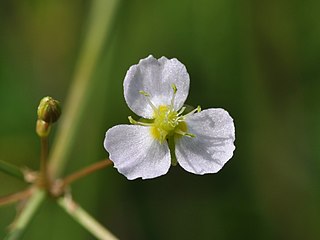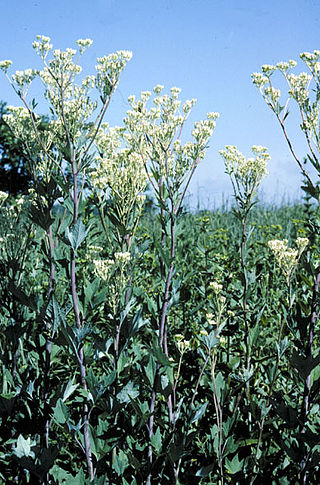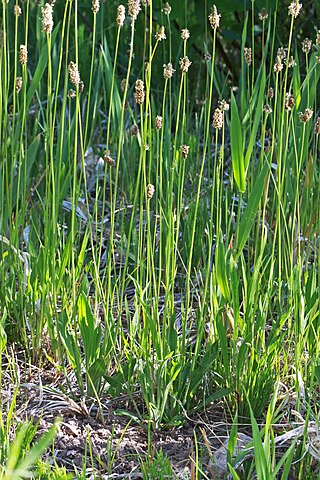
Plantago is a genus of about 200 species of flowering plants in the family Plantaginaceae, commonly called plantains or fleaworts. The common name plantain is shared with the unrelated cooking plantain. Most are herbaceous plants, though a few are subshrubs growing to 60 centimetres tall.

Alisma plantago-aquatica, also known as European water-plantain, common water-plantain or mad-dog weed, is a perennial flowering aquatic plant widespread across most of Europe and Asia, and apparently spread elsewhere in both the Old and New World.

Alisma is a genus of flowering plants in the family Alismataceae, members of which are commonly known as water-plantains. The genus consists of aquatic plants with leaves either floating or submerged, found in a variety of still water habitats around the world. The flowers are hermaphrodite, and are arranged in panicles, racemes, or umbels. Alisma flowers have six stamens, numerous free carpels in a single whorl, each with 1 ovule, and subventral styles. The fruit is an achene with a short beak.

Plantago lanceolata is a species of flowering plant in the plantain family Plantaginaceae. It is known by the common names ribwort plantain, narrowleaf plantain, English plantain, ribleaf, lamb's tongue, and buckhorn. It is a common weed on cultivated or disturbed land.

Plantago major, the broadleaf plantain, white man's footprint, waybread, or greater plantain, is a species of flowering plant in the plantain family Plantaginaceae. The plant is native to Eurasia.

Arnoglossum is a North American genus of plants in the family Asteraceae, described as a genus in 1817. They have the common name Indian plantain because they resemble the unrelated common plantain.

Plantago media, known as the hoary plantain, is a species of flowering plant in the plantain family Plantaginaceae. It is native to central and western Europe, including Great Britain and introduced to parts of the north-east United States. Its generic name is derived from the Latin for sole; like other members of the genus Plantago, it should not be confused with the unrelated plantain, a starchy banana.

Plantago ovata, known by many common names including blond plantain, desert Indianwheat, blond psyllium, and ispaghol, is native to the Mediterranean region and naturalized in central, eastern, and south Asia and North America.

Plantago maritima, the sea plantain, seaside plantain or goose tongue, is a species of flowering plant in the plantain family Plantaginaceae. It has a subcosmopolitan distribution in temperate and Arctic regions, native to most of Europe, northwest Africa, northern and central Asia, northern North America, and southern South America.

Plantago erecta is a flowering plant in the plantain family, commonly known as the California plantain, foothill plantain, dot-seed plantain, English plantain, and dwarf plantain. Plantago erecta is a small, unassuming annual herb with needle-like leaves and translucent flowers clustered on a stalk. It grows in sandy, clay, or serpentine soils, on grassy slopes and flats or open woodland, found in Baja California, California and Oregon. Plantago erecta is a host species for the Edith's checkerspot butterfly.

Plantago aristata is a species of plantain known by the common name bracted plantain or largebracted plantain. It is native to the eastern and central United States, and it can be found in other parts of North America as well as parts of Eurasia as an introduced species. It grows in many types of habitat, including disturbed areas, where it is a minor weed.

Plantago patagonica is a species of plantain known by the common name woolly plantain. It is native to much of North America, including the southern half of Canada, the western and central United States, and northern Mexico, and parts of southern South America. It grows in many types of habitat, including grassland and woodlands. It is a hairy annual herb producing linear or very narrowly lance-shaped basal leaves up to 10 centimetres (4 in) long. There are usually many stemlike inflorescences growing erect to a maximum height of around 15 cm (6 in). Atop the peduncle of the inflorescence is a dense cylindrical or somewhat conical spike of several tiny flowers and bracts. The spike is very woolly.

Plantago rugelii is an edible species of flowering plant in the plantain family, Plantaginaceae. It is native to North America, where it occurs in eastern Canada and the central and eastern United States. Its common names include American plantain, blackseed plantain, pale plantain, and Rugel's plantain. The species name rugelii honors Ferdinand Ignatius Xavier Rugel (1806-1879), a German-born botanist and pharmacist.

Plantago cordata is a species of flowering plant in the plantain family known by the common name heartleaf plantain. It is native to eastern North America, where it is distributed throughout eastern Canada and the eastern United States. Though it has a wide distribution, it is very localized, and populations have declined almost everywhere.

Plantago triantha is a species of flowering plant in the family Plantaginaceae that is native to Tasmania, Australia and the subantarctic Auckland Islands of New Zealand. Robert Brown described the species in 1810. Plants of this species of plantain are annual or perennial with a rosette habit, fleshy toothed leaves, and short inflorescences.

Plantago indica, commonly known as branched plantain, sand plantain, or black psyllium, is a flowering plant in the plantain family Plantaginaceae, and is one of a few species in the Plantago genus under the common name psyllium. The plant is native to parts of Africa, Europe, Russia, and Asia, and has been naturalized in many other areas such as Australia and North America. The plant can be found mostly in dry inland areas, such as those that are sandy, and has also naturalized on roadsides and in meadows. The plant is not used broadly as a food source, but has been cultivated for its seeds which serve a medicinal use as a laxative.

Plantago tweedyi, Tweedy's plantain, is a perennial herb in the plantain family. It is native to the western United States, from New Mexico and Arizona north to Montana.

Plantago virginica, common names hoary plantain and Virginia plantain, is a species of plant native to North America and introduced in Asia. It is listed as a special concern in Connecticut. The Kiowa use it to make garlands or wreaths for old men to wear around their heads during ceremonial dances as a symbol of health. It is commonly found within the continental United States in the majority of states along coastal areas and on roads, though has become an invasive species to eastern China after its introduction c. 1980. It is an annual plant, blooming around the month of May.

Plantago obconica is a species of flowering plant in the family Plantaginaceae that is endemic to the South Island of New Zealand. William Sykes described the species in 1988. It is the smallest Plantago species in New Zealand. Plants of this species of plantain are perennial with a rosette habit, with very narrow, linear, keeled leaves, and fruiting capsules with a 1-cm long funnel-like base.


















